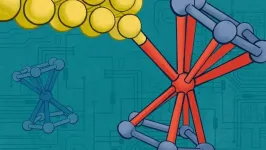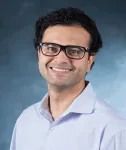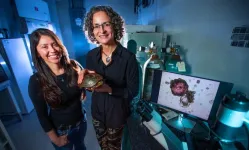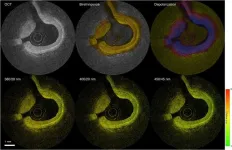(Press-News.org) FOR IMMEDIATE RELEASE
Media Contact: LEVI GADYE (628) 399-1046
Levi.Gadye@ucsf.edu
Subscribe to UCSF News
A Smart Molecule Beats the Mutation Behind Most Pancreatic Cancer
Scientists discover a new way to disarm a deadly protein that also appears in cancers of the lung, breast and colon.
UC San Francisco researchers have designed a candidate drug that could help make pancreatic cancer, which is almost always fatal, a treatable, perhaps even curable, condition.
The new molecule permanently modifies a wily cancer-causing mutation, called K-Ras G12D, that is responsible for nearly half of all pancreatic cancer cases and appears in some forms of lung, breast and colon cancer.
Pancreatic cancer is less common than these other cancers, but the lack of treatment options makes it more deadly, and it claims more than 50,000 lives each year in the United States.
“We’ve worked for ten years to bring pancreatic cancer therapies up to speed with therapies for other cancers,” said Kevan Shokat, PhD, a professor in the Department of Cellular and Molecular Pharmacology who led the work. “This breakthrough is the first to target G12D and gives us a firm foothold to fight this devastating mutation.”
The findings appear March 5, 2024, in Nature Chemical Biology.
Shokat and his colleagues developed the first cancer drugs to stop a different K-Ras mutation, G12C, in 2013. Since then, two therapies have been approved for use in lung and breast cancer, but the advance didn’t move the needle for treating pancreatic cancer.
An extremely common mutation
K-Ras mutations are extremely common in pancreatic cancer, explaining 90% of cases. About half of these mutations are G12D, which differs from most other K-Ras mutations by a single amino acid substitution.
This slight difference between healthy and cancer-causing proteins, in which glycine (G) becomes aspartate (D), presented a monumental challenge for chemists.
“There are very few molecules out there that can sense the difference between the cancer-causing aspartate and the glycine,” Shokat said. “To make good therapies, we need drugs that work on the tumor cells only, without affecting healthy cells.”
Shokat’s team envisioned a molecule that fit into a pocket of the K-Ras protein, then firmly – and irreversibly – bound to the rogue aspartate. The explosion of research that followed Shokat’s 2013 discovery enabled them to develop a template for chemicals that reliably found their way into that corner of the protein.
“Once we had that structure for our molecules, we knew they were sitting in the protein at the right spot,” Shokat said. “Then we could explore the little nooks and crannies that we needed to discover the chemistry of the aspartate.”
Could a bend in a molecule lead to a cure?
The scientists went through dozens of chemicals.
“It’s like climbing a new route on a mountain, you may be strong but the lengths of your arms limit what you can do,” Shokat said. “It was a lot of trial and error, tweaking the branches of these molecules to position them in this incredibly tight space around G12D. Some got close, then failed, and we would start over.”
Eventually, they found a winning molecule. It settled into the appropriate corner of K-Ras and bent into a new shape that reacted strongly with the aspartate.
The molecule put the brakes on tumor growth from G12D in cancer cell lines, as well as an animal model of human cancer. And it never attacked healthy proteins.
The scientists are now optimizing the molecule to be durable enough to fight cancer in the human body. With the traction gained from this study, Shokat said, new therapies for pancreatic cancer could enter clinical trials in as little as two to three years.
“We’ve learned a lot from other targeted therapies and know how to quickly translate discoveries like these for the clinic,” said Margaret Tempero, MD, director of the UCSF Pancreas Center. “An effective drug targeting K-RAS G12D could be transformative for patients with pancreatic cancer.”
For funding and disclosures, see the paper.
Other UCSF authors are Quinheng Zheng, Ziyang Zhang, and Keelan Z. Guiley. Zhang is now a professor at UC Berkeley.
About UCSF: The University of California, San Francisco (UCSF) is exclusively focused on the health sciences and is dedicated to promoting health worldwide through advanced biomedical research, graduate-level education in the life sciences and health professions, and excellence in patient care. UCSF Health, which serves as UCSF's primary academic medical center, includes top-ranked specialty hospitals and other clinical programs, and has affiliations throughout the Bay Area. UCSF School of Medicine also has a regional campus in Fresno. Learn more at https://ucsf.edu, or see our Fact Sheet.
###
Follow UCSF
ucsf.edu | Facebook.com/ucsf | YouTube.com/ucsf
END
A smart molecule beats the mutation behind most pancreatic cancer
2024-03-05
ELSE PRESS RELEASES FROM THIS DATE:
Using light to precisely control single-molecule devices
2024-03-05
In a new Nature Communications study, Columbia Engineering researchers report that they have built highly conductive, tunable single-molecule devices in which the molecule is attached to leads by using direct metal-metal contacts. Their novel approach uses light to control the electronic properties of the devices and opens the door to broader use of metal-metal contacts that could facilitate electron transport across the single-molecule device.
The challenge
As devices continue to shrink, their electronic ...
Boston College researchers use electrocatalysis for site-specific protein modification
2024-03-05
Chestnut Hill, Mass. (03/05/2024) – Boston College researchers used a mild charge of electricity to precisely modify proteins, a new tool that can be used to develop novel biotherapeutics and protein-based research tools, the team reported recently in the journal Nature Chemistry.
The team, led by BC professors of chemistry Abhishek Chatterjee and Eranthie Weerapana, developed and optimized a novel electrochemical protein labeling reaction called "eCLIC", that enables precise modification of site-specifically incorporated 5-hydroxytryptophan (5HTP) residues on many different proteins including full-length therapeutic antibodies.
“We used this strategy to generate ...
Infotainment is coming for your news, warns Concordia Ph.D. student Robert Marinov
2024-03-05
There are plenty of reasons to worry about the quality of contemporary Canadian journalism, beyond shrinking newsrooms and attention spans.
Once considered a vital pillar of a healthy democracy, the country’s biggest newspapers have been embracing the type of content critics refer to as “infotainment,” which uses entertainment-style methods to communicate politically relevant information.
In a new paper published in the Canadian Journal of Political Science, PhD candidate Robert Marinov examines, measures and evaluates the scope and nature ...
Lab-grown liver organoid to speed up turtle research, making useful traits easier to harness
2024-03-05
AMES, Iowa – At a Biotechnology Council event a few years ago, Nicole Valenzuela’s ears perked up when she heard what a group of researchers in Iowa State University’s College of Veterinary Medicine had in the works: a method for creating a lab-grown, simplified mimic of dog intestines.
“I told them, ‘Oh! I want to do that but with turtles. Is it doable?” said Nicole Valenzuela, professor of ecology, evolution and organismal biology at Iowa State.
It is indeed doable, new research from a team led by Valenzuela shows. The three-dimensional clusters ...
Patients with Parkinson’s disease who experience freezing of gait have sleep disorders, study shows
2024-03-05
Parkinson’s disease patients who experience freezing of gait (a sudden inability to initiate or continue movement, often resulting in a fall) wake up several times during the night, feel sleepy during the day, and have REM sleep behavior disorder. Rapid eye movement (REM) sleep plays a role in the maintenance of many cognitive processes.
These are key findings of a study supported by FAPESP and conducted by researchers at São Paulo State University (UNESP) in Brazil and Grenoble Alps University (UGA) in France. An article on the study is published in ...
Study finds no safety concerns when the dapivirine vaginal ring is used during the second and third trimesters of pregnancy, according to results presented at CROI 2024
2024-03-05
PITTSBURGH, March 5, 2024 -- Results of the third and final cohort of the DELIVER (MTN-042) Phase IIIb study found no safety concerns with use of the monthly dapivirine vaginal ring beginning during the second trimester of pregnancy and up to the time of delivery, researchers reported today at the Conference on Retroviruses and Opportunistic Infections (CROI 2024) in Denver. With this latest data, the researchers believe there is now sufficient evidence that the dapivirine ring is safe to use ...
After decades of Arctic sea ice getting faster and more hazardous for transport, models suggest a dramatic reversal is coming, York University study finds
2024-03-05
TORONTO, March 5, 2024 – Will ice floating in the Arctic Ocean move faster or slower over the coming decades? The answer to this question will tell us whether marine transportation can be expected to get more or less hazardous. It might also have important implications for the rate of ice cover loss, which is hugely consequential for Northern Indigenous communities, ecosystems, and the global climate system.
While observational data suggest the trend has been towards faster sea ice speeds, ...
Pioneering work in computational and theoretical neuroscience is awarded the world’s largest brain research prize
2024-03-05
The Lundbeck Foundation has announced the recipients of The Brain Prize 2024, the world’s largest award for outstanding contributions to neuroscience. This year’s award recognizes the pioneering work of three leading neuroscientists – Professor Larry Abbott at Columbia University (USA), Professor Terrence Sejnowski at the Salk Institute (USA), and Professor Haim Sompolinsky at Harvard University (USA) and the Hebrew University (Israel).
Theoretical and computational neuroscience permeates neuroscience today ...
New cardiovascular imaging approach provides a better view of dangerous plaques
2024-03-05
WASHINGTON — Researchers have developed a new catheter-based device that combines two powerful optical techniques to image the dangerous plaques that can build up inside the arteries that supply blood to the heart. By providing new details about plaque, the device could help clinicians and researchers improve treatments for preventing heart attacks and strokes.
Atherosclerosis occurs when fats, cholesterol and other substances accumulate on the artery walls, which can cause these vessels to become thick ...
BU study finds robotic-assisted surgery for gallbladder cancer as effective as traditional surgery
2024-03-05
(Boston)—Each year, approximately 2,000 people die annually of gallbladder cancer (GBC) in the U.S., with only one in five cases diagnosed at an early stage. With GBC rated as the first biliary tract cancer and the 17th most deadly cancer worldwide, pressing attention for proper management of disease must be addressed. For patients diagnosed, surgery is the most promising curative treatment. While there has been increasing adoption of minimally invasive surgical techniques in gastrointestinal malignancies, including utilization of laparoscopic ...





